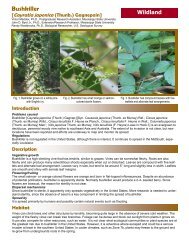RATopic1_95 - Geosystems Research Institute - Mississippi State ...
RATopic1_95 - Geosystems Research Institute - Mississippi State ...
RATopic1_95 - Geosystems Research Institute - Mississippi State ...
You also want an ePaper? Increase the reach of your titles
YUMPU automatically turns print PDFs into web optimized ePapers that Google loves.
Thomas Simonsen and Richard Brown<br />
The use of cactus as larval hosts has been most developed in<br />
genera of Pyralidae, specifically the Phycitinae. Surveys of<br />
the cactus moth, Cactoblastis cactorum, have concentrated<br />
on surveys of prickly pear cacti in the genus Opuntia<br />
(subgenus Platyopuntia). However, other genera of cacti,<br />
e.g., Cylindropuntia and Consolea, which were formerly<br />
regarded as subgenera of Opuntia, also have been recorded<br />
as hosts of the cactus moth. In order to determine the ancestral<br />
host of Cactoblastis, the evolution of larval hosts in<br />
these genera were analysis. The analysis was made with<br />
Mesquite 2.71, a modular system for evolutionary analysis<br />
(Maddison & Maddison 2009), based on the phylogeny presented<br />
by Simonsen (2008).<br />
Evolution of Host Preferences in Cactus-Feeding Pyralidae<br />
Figure 1. Phylogenetic tree of cactus feeding Pyralidae and<br />
their relatives with evolution of host preferences.<br />
The results of our analysis of the evolution of cactus feeding<br />
in Pyralidae are shown in Figure 1. Cactus-feeding has<br />
evolved once in the Pyralidae and subsequently was lost in<br />
the genus Rhagea, which has switched to feeding on plants<br />
in the family Crassulaceae (live-forever). The two basal<br />
lineages within the cactus-feeding clade, Cactobrosis and<br />
Echinocereta, feed on two genera of barrel-like cacti,<br />
Ferrocactus and Echinocerus respectively. However, our<br />
analysis indicates that the last common ancestor of the remaining<br />
cactus-feeders fed on an “Opuntioid” cactus. The<br />
genus Opuntia s.l. has recently been split into several<br />
smaller genera of which cactus-feeding phycitines feed on<br />
three: Opuntia s.s. (=Platyopuntia), Cylindropuntia, and<br />
Consolea. When these three genera are treated as „Opuntia<br />
s.l.‟ in the analysis, Opuntia s.l. feeding appears to have a<br />
single origin. Though Opuntia s.l. feeding has been lost<br />
independently in the genera Eremberga, Sigelgaita and Yosemitia,<br />
this scenario opens up for the intriguing possibility that the ancestor of the Opuntia s.l. feeders fed on the last common<br />
ancestor of Opuntia s.l., and that the two clades subsequently have co-evolved. Of the three non-Opuntia s.l. feeders in<br />
this clade, Eremberga and Sigelgaita are both restricted to a few genera of barrel-like or rod-like cacti (Echinocerus, Echinopsis,<br />
and Eulychina). However, the small genus Yosemitia feeds on a wide variety of barrel-like cacti.<br />
It is uncertain if the ancestral “Opuntoid” host was a member of Platyopuntia or Cylindropuntia because both genera are<br />
used as hosts by the basal genera, Nanaia and Alberada on Cylindropuntia and Melitara on Platyopuntia. However, the<br />
basal genera in the clade containing Cactoblastis feed on Platyopuntia, suggesting that this was the ancestral host in Cactoblastis.<br />
Predacious larvae feeding on scale insects have evolved independently in the non cactus-feeders Laetilia and Baphala, and<br />
the cactus-feeder Salembona. Laetilia and Baphala are apparently primarily predacious in all life stages (Neunzig 1997).<br />
However, in Salembona the larvae feed on flowers, fruit and shoots of Opuntia s.s. in the spring, but switch to mealy bugs<br />
on Opuntia later in the year (Mann 1969).<br />
References<br />
Maddison W.P., Maddison D.R. 2009. Mesquite: a modular system for evolutionary analysis. Version 2.71. http://mesquiteproject.org<br />
Simonsen, T.J. Phylogeny of the cactus-feeding phycitines and their relatives (Lepidoptera, Pyralidae) based on adult morphology:<br />
evaluation of adult character-systems in phycitine systematics and evidence for a single origin of Cactaceae-feeding larvae. Insect Syst.<br />
Evol. 39: 303-325.<br />
2009 USGS Annual Report 20 <strong>Mississippi</strong> <strong>State</strong> University’s <strong>Geosystems</strong> <strong>Research</strong> <strong>Institute</strong>




